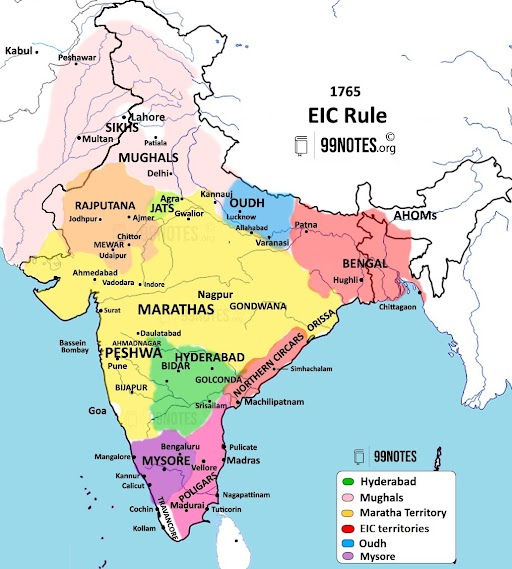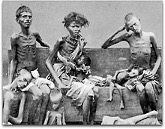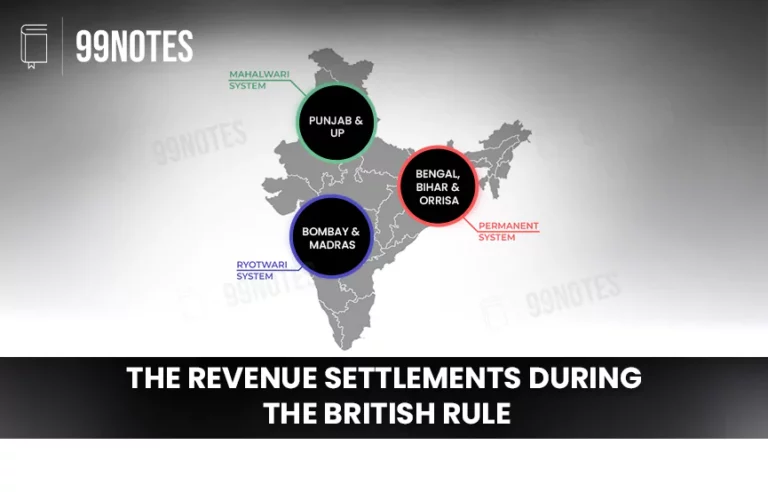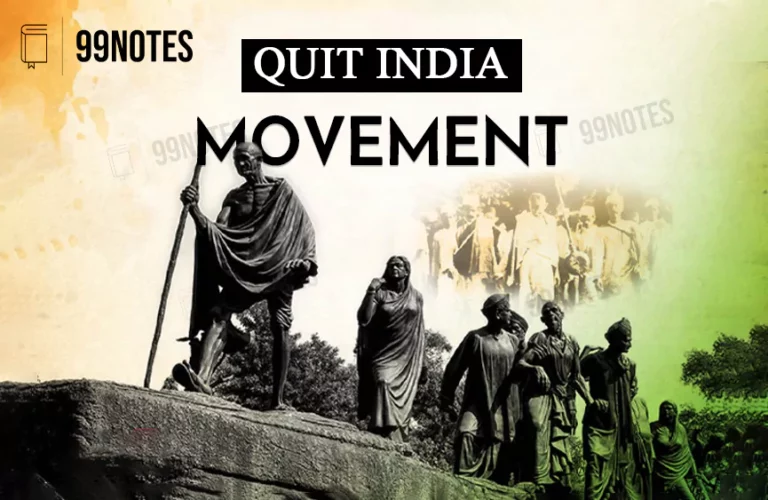Establishment of the British Rule in India: Timeline and Impact- Complete UPSC Notes
India before the British rule in India
Political scenario in India
- The Mughals – After the death of Aurangzeb in 1707, the decline of the Mughals started. Rulers of the Mughals were now weak and engrossed in political conflict for inheritance or dominance in the court.
- The Marathas – The third battle of Panipat in 1761 weakened the Maratha empire. It gave the British to consolidate their power in South India and Bengal.
- The Mysore – Hyder Ali, a Dalavayi (commander-in-chief) to Krishnaraja Wodeyar II (reign 1735–1766), became the de facto ruler of Mysore as Sarvadhikari (Chief Minister) by
- The Hyderabad – The governor of Hyderabad, Mir Qamar-ud-Din Siddiqi (also known as Asaf Jah), declared independence (1724) after the weakening of the Mughal authority. There were constant invasions from the Marathas Empire. After his death, the inheritance struggle saw the interference of British and French power.
- The Bengal – In the early 18th century, the Nawab of Bengal, Murshid Quli Khan, became the de facto free ruler of the 3 regions of Bihar, Bengal and Orissa. The region was an important production centre for several items such as cotton and textiles, gunpowder, saltpetre etc. In addition, the area became a base for European trading companies.
The economic situation of India before British Rule
- Agriculture – Peasants paid exorbitant amounts to the state, the zamindars, the jagirdars, and the revenue farmers. This increased poverty among them.
- Trade and Industry – As the European trading company established their trade, the prosperity of the traditional Indian merchants such as Bohra Muslims and Jains declined. The East India Company started asserting its monopoly right to trade with India with increased political power.
Society of India before British Rule
- Status of education – The traditional Indian education system lagged behind the education system of the West. The Muslim and Hindu elementary schools were called maktabs and pathshalas, Chatuspathis, or Tols, were the centres of higher education. Centres for Sanskrit education were Tirhut (Mithila), Kasi (Varanasi), Utkala and Nadia. Persian and Arabic were taught in Madrasahs. Azimabad (Patna) was well-known for Persian education.
- Status of women – Patriarchal family system was widespread. While upper-class women remained at home, lower-class women worked in fields and outside their homes, supplementing the family income. Purdah, sati, child marriage, dowry, and polygamy existed. Raja Sawai Jai Singh of Amber and Prashuram Bhau (Maratha General) tried to promote widow remarriage.
- Status of Caste – Society was divided into the four Varna systems and numerous sub-castes. Caste councils and panchayats enforced caste norms and regulations. Muslims were divided into Sunni and Shia and the Irani, Afghan, Turani, and Hindustani Muslims. Slavery was widespread.
The British Conquest of Bengal

The situation of Bengal on the eve of the British conquest
- Bengal was the wealthiest Mughal empire province.
- By 1691, the British East India Company got royal Farman from the Mughal emperor to “continue their trade contentedly in Bengal” in exchange for a yearly payment of Rs 3,000 to the Mughal Emperor.
- And by 1715, the Company got additional Farmans from the Mughal Emperor These Farmans enabled the Company to issue dastaks (a tax freed trade permit) to the European traders.
- Later, Alivardi Khan (1740-56), the Nawab of Bengal, stopped paying tributes to the Mughal Emperor. Under him, the Bengal prospered.
- Siraj-ud-Daulah succeeded his grandfather in 1756.
- The British conquest of Bengal began with the battle of Plassey (1757)
The Battle of Plassey (1757)
In 1756, young Siraj-ud-Daulah succeeded his grandfather as the Nawab of Bengal. He immediately identified that the British were misusing the Farukh Siyar’s farman to run even private trade tax-free. This led to a lot of leakage in revenue.
He took a series of steps that ensured that the conflict with the British was eminent.
Causes for the Battle of Plassey:
Reasons for the Nawab’s discontent –
-
- The special privileges and their misuse enjoyed by the English Company meant a massive loss to the Bengal exchequer.
- The English fortified Fort William at Calcutta without the Nawab’s permission.
- The Company gave asylum to Krishna Das (a political fugitive), the son of Raj Ballabh. He had fled with immense treasures against the Nawab’s will.
Reasons for The East India company’s discontent –
-
- They thought that Siraj would reduce their trading privileges in collaboration with the French in Bengal.
The Black Hole Tragedy
-
- Siraj-ud-Daulah captured Qasimbazaar and Fort William in Calcutta from the under-prepared English governor Robert Drake.
- In Fort William, he imprisoned 146 English persons. They were lodged in a tiny room, of which 123 died of suffocation. This tragedy is known as the Black Hole Tragedy.
The Battle
Robert Clive was a British commander posted in Madras when the events in Bengal took place. In 1756, various diplomatic efforts were made from the British side, but Siraj did not respond. Thus, Clive’s forces of a couple of 1000 men were dispatched.
In early surprise attacks, the Nawab was intimidated. He tried to come to terms with Clive and surrender Calcutta, even promising to compensate the British for their losses. He also made a few unsuccessful attempts to secure an alliance with the French.
On the other hand, Clive allied with Mir Jafar (Siraj’s commander-in-chief), Jagat Seth (an influential banker of Bengal), Rai Durlabh, and Omichand against Siraj-ud-Daulah.
On the day of the battle, due to rain, Siraj’s cannons weren’t functioning; the betrayal of Mir Jafar’s and several of his key associates also dampened the morale. Thus, without much fight, Robert Clive’s technically superior forces defeated Siraj-ud-Daulah in the Battle of Plassey (June 23, 1757).
After the battle, Siraj was executed on Mir Jafar’s order.
Result of Battle of Plassey
As per the agreement between Mir Jafar and Clive, the battle resuted in three important developments:
- Mir Jafar was made the Nawab of Bengal but depended on Robert Clive’s support to maintain his position.
- He granted free trade, a large sum of money and a zamindari of 24 Parganas to the English.
- The English posted a resident in the court of the Nawab.
Significance of Battle of Plassey
- Military Implications: The Battle of Plassey established the military supremacy of the English in Bengal.
- Economic implications: It ensured revenue from the Zamindari of 24 Parganas, and the trade was virtually duty-free.
- Strategic Implications: The revenue from the obtained territories helped maintain an adequately equipped military force.
The Battle of Plassey was the first step in building a British empire in India.
Mir Jafar’s Administration:
Mir Jafar’s rule as Nawab was not as smooth as he had thought. A British resident was placed in his court who interfered in his day to day affairs, and due to restriction-free trade the revenues were dwindling.
In such circumstances, he supported the Dutch in the battle of Hooghly/Chinsurah/Biderra (1759). But the English defeated the Dutch. Moreover, Mir Jafar failed to make the due payments to the Company.
Thus, company decided to replace Mir Jafar with someone more obedient.
Mir Kasim
After the death of Mir Jafar’s son Miran, Vansittart, the new Governor of Calcutta, supported Mir Kasim (the son-in-law of Mir Jafar) to become the Nawab of Bengal. Mir Jafar was ousted with a pension of Rs 1,500 per annum.
In 1760, Mir Kasim and the Company signed a treaty upon his appointment with the following terms:
- The Company got the districts of Burdwan, Midnapur, and Chittagong.
- They got half of the revenue in the chunam trade of Sylhet.
- Mir Kasim agreed to pay the dues and a sum of five lakh rupees towards financing the Company’s war efforts in southern India.
- It was acknowledged that Mir Kasim’s enemies would be treated as Company’s enemies and his friends, the Company’s friends.
- It was decided that the Nawab’s territory’s subjects would not be accommodated in the Company’s land and vice-versa.
Vary of British ways, after becoming Nawab, Mir Kasim immediately undertook two reforms:
- He transferred the capital from Murshidabad to Munger in Bihar, which allowed him to have a safe distance from the Company.
- He reorganised the bureaucracy and the army to enhance their skill and efficiency.
Again, it was clear that the relation between the Nawab and the British wouldn’t be as smooth as the British had imagined.
The Battle of Buxar (1764)
Eventually, the growing differences led to the Battle of Buxar that officially gave the control over all of Bental to the British.
Causes of the Battle of Buxar:
Reasons for the Nawab’s discontent –
-
- The English supported the defiant deputy governor of Bihar, Ram Narayan, against Mir Kasim.
- Dastak System –The Company’s official misused the dastak system, which led to the loss of tax revenue to the Nawab. The Company’s servants also asserted the same privileges for their private trade and sold dastak to Indian merchants for a commission. They forced merchants to get goods at trivial rates, which was against duty-free trade.
Reasons for Company’s discontent –
-
- British protested when Mir Kasim decided to abolish the duties altogether.
- They wanted preferential treatment against other traders.
Due to these issues, there were battles between the Company and The Nawab in 1763. The English defeated Mir Kasim forces at Murshidabad, Katwah, Munger, Sooty, and Giria.
Mir Jafar was reinstalled with a monthly payment of ₹5,00,000/month to the British. This was against the policy of treating Kasim’s enemies as company’s enemies.
Being uneasy of the Company’s intentions, Mir Kasim escaped to Awadh (or Oudh) and formed a coalition with, Shuja-ud-Daulah (the Nawab of Awadh) and Shah Alam II (the Mughal Emperor).
The Battle : On October 22, 1764, the English forces under Major Hector Munro defeated the combined armies of Mir Kasim, Shuja-ud-Daulah and Shah Alam II in Buxar. In the battle, the British were aided by the likes of Zamindar Balwant Singh.
Result of Battle of Buxar
- The English were granted the districts of Midnapore, Burdwan, and Chittagong for their army’s maintenance.
- The English were also allowed duty-free trade in Bengal, except for a duty of 2 per cent on salt.
- After Mir Jafar’s death, his minor son, Najim-ud-daula, was made the Nawab.
- But the real power of administration was laid with the naib-subahdar, who was generally appointed or dismissed by the English.
This had great significance as the English defeated the Nawab of Bengal and the Mughal Emperor of India. This victory essentially made the British the supreme power in northern India and contenders for supremacy over the whole country.
After the battle of Buxar, the British forced the Treaty of Allahabad on the parties involved.
Significance of Battle of Buxar
The victory of English over Nawab of Bengal and the Mughal Emperor of India made the British the supreme power in northern India and contenders for supremacy over the whole country.
The Treaty of Allahabad (1765)
In August 1765, Robert Clive concluded two treaties at Allahabad –
Treaty of Allahabad With the Nawab of Awadh, Shuja-ud-Daula
-
- Surrender Kara and Allahabad to Shah Alam II
- A payment of Rs 50 lakh is to be paid to the Company as war indemnity
- Balwant Singh, Zamindar of Banaras, was given full possession of Nawab’s estate.
Treaty of Allahabad With the Mughal Emperor, Shah Alam II
-
- He was to reside at Allahabad under the Company’s protection.
- A farman was issued by him granting the Diwani rights of Bengal, Bihar, and Orissa to the EIC in exchange for Rs 26 lakh/annum payment.
On September 30, 1765, another agreement was signed with the Nawab of the Bengal, Nazmuddaula, under which the Company agreed to pay the Nawab Rs. 53 lakhs annually to defray the costs of Nizamat (civil) administration and the Nawab’s household.
Treaty on Northern Circars: In 1765, Shah Alam also granted five ‘sarkars’, in the norther
circar region.
Evaluation of the Allahabad treaty
- Awadh was not annexed as it would have required the Company to defend an extensive land frontier from the Afghan and the Maratha
- According to the treaty Nawab of Awadh, a friend of the Company, turned Awadh into a buffer state, a predecessor of the Ring fence theory.
- Shah Alam II was made a ‘rubber stamp’ of the Company.
- The farmans legalised the political gain of the Company in Bengal.
The British Administration of Bengal
Dual Government in Bengal (1765–72)
After obtaining the revenue rights, Robert Clive brought the dual system of government to Bengal. It means the rule of the two –
The Company’s rules –
-
- It exercised the Diwani rights (right of collecting revenue) as the Diwan.
- But it didn’t collect the revenue directly and appointed two Naib Dewans, Muhammad Raza Khan and Raja Shitab Ray, for Bengal and Bihar,
The Nawab’s rule –
-
- The Nawab was in charge of maintaining peace and order (Nizamat functions).
- The Company also appointed Muhammad Raza Khan as the naib Nizam (Nazim).
This system led to a peculiar situation:
- As Naib, Nazim Muhammad Raza Khan had to represent the Nawab, and
- As naib diwan, he has to represent the Company.
This system of government was known as the Dual Government.
The revenue reforms during East Indian Company
Initially the British continued with the revenue system that existed during the later Mughals. However, eventually they introduced a few reforms:
- The Izaredari system (1773) – After obtaining the revenue rights, the British sought to suck as much revenue as it could. Thus, in 1773 Warren Hastings (1772-1785) introduced the Izaredari system. In this system, the right to collect revenue from an area was auctioned to the highest bidder, Izaredar, who paid the Company its share.
- Hastings established a Board of Revenue and appointed an Accountant General.
- The revenue sale law (1793): If Zamindar failed to pay the revenue regularly, the government sold his land to recover dues. The land and right to collect its revenue were transferred to the new Zamindar. This law was popularly known as the Sunset Law.
Reforms during British Rule in India
1. Trade reforms
-
- Warren Hastings (1772-85) abolished the Dastak System and introduced a reform tariff of 2.5% of tax on Indian and non-Indian goods.
- Lord Cornwallis (1786-93) stopped the private trade carried out by the servants of the East India Company.
2. Legislative reforms
Regulating Act of 1773 –
It laid the foundations of the British administration in India, and regulated the Company’s functions:
The governance of Bengal
-
- The governor-general of Bengal was made superior to the Governors of Bombay and Madras presidencies.
- It created an Executive Council of four members to assist the Governor-general of Bengal.
The governance of the Company
-
- It consisted of the Court of Directors and the Court of Proprietors.
- It made it compulsory to renew Company Charter every 20 years.
Pitt’s India Act of 1784 –
-
- It reduced the number of Executive council members to three.
- It distinguished the political and commercial functions of the Company.
- A new system of Double Government –
-
-
- The government’s political (civil and military) functions and revenue functions were now supervised by a newly created body, the Board of Controls.
- The Court of Directors continued to manage the commercial affairs.
-
3. Judicial reforms
Reforms in the courts –
-
-
- Each district had a civil court under Collector and a criminal court under an Indian Judge.
- Sadar Diwani Adalat and Sadar Nizamat Adalat were the highest courts of appeal for civil and criminal matters, respectively.
- Supreme Court of Calcutta (1774) was established, consisting of four judges having jurisdiction over all the inhabitants of Calcutta.
- Four provincial courts at Calcutta, Dhaka, Murshidabad and Patna, each under three European judges, were established.
- Indian judges (Munsiffs) were appointed to bottom courts.
- Hindu and Muslim laws were followed in civil cases.
-
Codification and the study of laws –
-
-
- Code of Gentoo was translated from Persian into English by B. Halhed.
- Sanskrit College of Benaras (1791) by Jonathan Duncan and Calcutta Madarsa (1781) by Warren Hastings were established to study the Hindu and Muslim law, respectively.
-
Impact of British rule in India (of Policies)
Lawlessness
- The Dual Government of Robert Clive proved to be a failure. The Nawab was only a puppet ruler with no power, and the Company officials had power with no responsibility. Neither the Company nor the Nawab was concerned with governance or public welfare.
- The servants of the Company indulged in bribery and corruption. Theft, beggary and dacoity were prevalent throughout the territory.
Eventually, Warrant hastings ended the Dual government.
Revenue Exploitation:
The British continued the exploitative system of revenue administration that existed during the later Mughal
rule and made it more severe using the temporary settlement and the permanent settlement reforms
Bengal Famine of 1770
- The Bengal Famine occurred in Bengal and Bihar and affected some 30 million people. The smallpox epidemic accompanied it.
- Monsoon failures compounded by the East India Company’s policies were the reasons for the Bengal famine.
- It became the subject matter of Bankim Chandra Chatterjee’s Anandamath.
- Causes of Bengal Famine –
-
- The dual system of government of Robert Clive –This system neglected the plights and concerns of the peasants of approaching famine and a decrease in production.
- Revenue maximisation policies – The Company’s concern was only revenue maximisation. The zamindars who could not pay the tax regularly had their land auctioned off. Moreover, paying of tax was mandatory even during drought or any natural calamities. There was hardly any willingness to set up any regular system of assessment and collection
- Lack of trained administrators – The Company got Diwani rights after the Battle of Buxar but found itself short of trained administrators familiar with the local law and tradition.
- The monopoly of trade – The Company forced artisans to sell their goods at low prices, which led them to desert the villages. This disrupted traditional rural structure and economy.
- Storage issues – Due to the taxation system’s rise, the producers could not store the excess production as it had to be paid at the increased tax rate.
- Forced production of cash crops – The farmers were coerced to produce cash crops like Indigo and opium to boost British exports. This decreased the production of edible crops.
Impact of British rule on trade in India
1. The plight of Native Merchants –
-
- Due to the Dastak system, the Indian merchants failed to compete with the Company’s trade.
- Moreover, the Company’s servants started to trade privately by selling the Dastak to Indian merchants at exorbitant prices.
2. Balance of Payments –
-
- Before 1765, the Company used to purchase goods in India. They also imported gold and silver from Britain, which made the balance of payments favourable to India.
- However, after getting the Dewani rights, they bought the goods from the revenue collected in Bengal. As a result, gold and silver imports from England stopped. This led to the drain of money from India.
Impact on Industry
- Textile Industry – The Calico Acts (1700, 1721) of the British parliament restricts the import of most cotton textiles into England. The Company’s servant used to arbitrarily decide the quality of the cloth, its quantity of production and its price. This severely affected the cotton textile in India.
- The plight of Artisans – Due to the monopoly of the Company, the artisans were forced to sell their goods at lower prices. The protesting artisans were severely punished. As a result, many artisans were leaving their trade, affecting the industry they were involved in.









